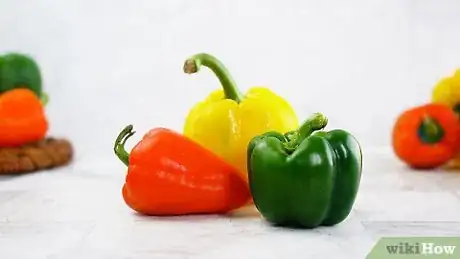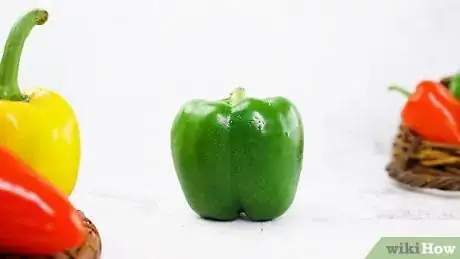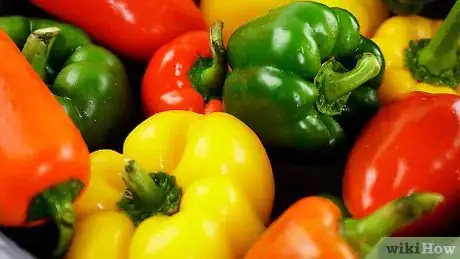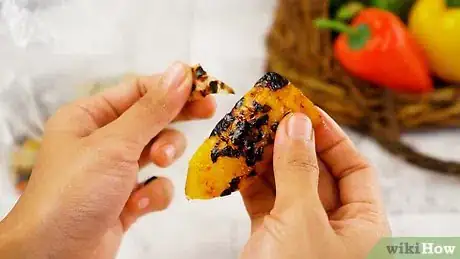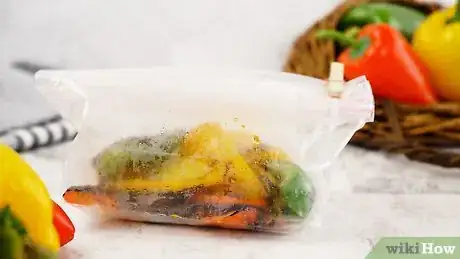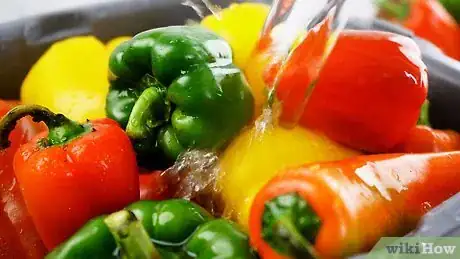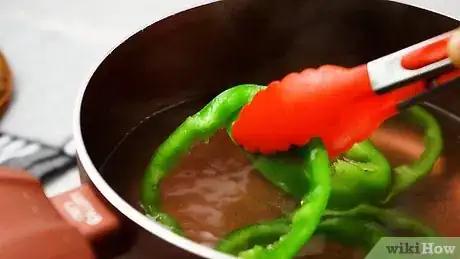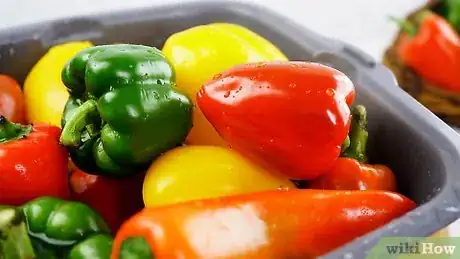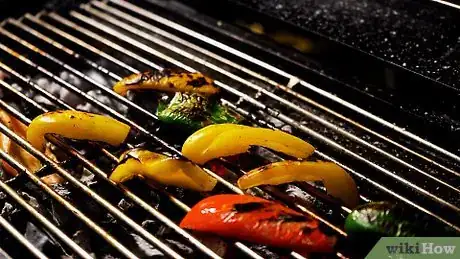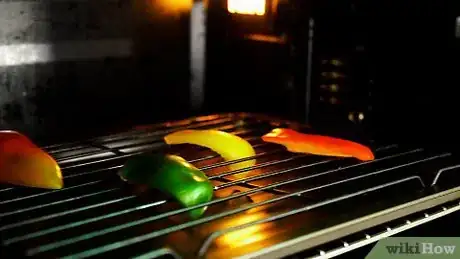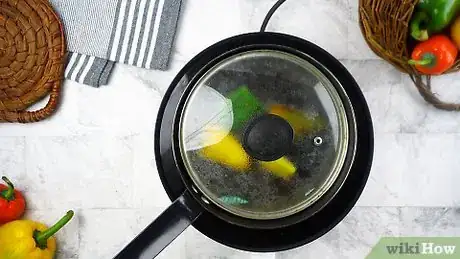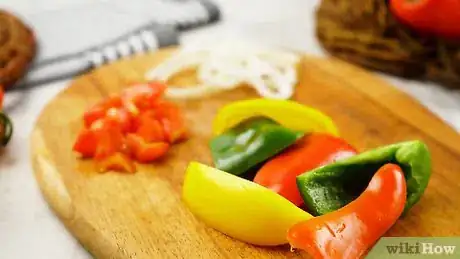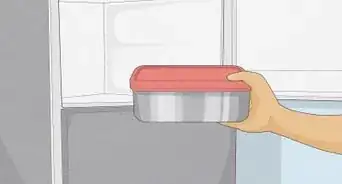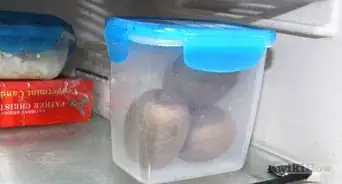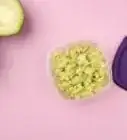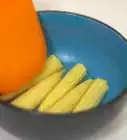wikiHow is a “wiki,” similar to Wikipedia, which means that many of our articles are co-written by multiple authors. To create this article, volunteer authors worked to edit and improve it over time.
The wikiHow Culinary Team also followed the article's instructions and verified that they work.
This article has been viewed 12,557 times.
Learn more...
Bell peppers (also known as capsicums, sweet peppers or pimento) are a versatile vegetable with many possibilities for inclusion in cooking. They can be added to many dishes or they can be the star of the dish, depending on what you'd prefer. This article covers choosing bell peppers, preparing them and deciding how to cook with them.
Steps
Choosing Bell Peppers
-
1Use bell peppers when in season. They are at their best when in season locally. Outside of season they have to be imported or grown in greenhouses, which makes them more expensive and they are often not as fresh as during the summer months.
- Green peppers tend to be available first in the season, followed by the other colors later.
- In the Northern Hemisphere, the peak season for bell peppers is August to September, with main availability being from July to October. If you live in a warmer climate, the season will last much longer.
- In the Southern Hemisphere, the peak season for bell peppers is December to March. If you live in a warmer climate, the season will last much longer.
-
2Choose a color. Bell peppers come in a variety of colors, mainly reds, greens, yellows, oranges and purples. While red and green are the most popular, all types are good for eating. The color is mainly a preference, although there are slight flavor differences between the different colors, depending on the type of pepper and its source.
- Red peppers have been allowed to fully ripen before being picked.
Advertisement -
3Choose firm and glossy bell peppers when shopping for them. The bell pepper should be hard and crisp, not soft and mushy. If buying green bell peppers, the green should be dark; if it's too light, the pepper may be unripe. Reject peppers that are shriveled and soft or that have damp, soft patches; these have passed their best-by date. If the stem has any mildew or decay, avoid it. Black spots indicate rain damage.
- If the shriveled ones are a bargain, it is possible to salvage them for sauces and chutneys, or for placing inside dishes where their flavor is desired but their appearance doesn't matter.
-
4Choose a good, widely-shaped pepper for stuffing. If you are stuffing peppers, choose ones that are of a decent size for adding in the stuffing. If possible, test to see if they can stand upright already on their own, as this can be helpful but not essential.
-
5Store bell peppers properly. Before using the bell peppers, keep them in the refrigerator in the crisper. They do not need to be washed until use.
Preparing Bell Peppers
-
1Wash and dry before use. A gentle rinse and wipe will usually be sufficient to clean the bell pepper.
-
2Prepare according to the needs of the recipe. The preparation of a bell pepper depends on how you intend to use it. The main ways to prepare a bell pepper are as follows:
- Diced or cut into small pieces to add to pasta sauces, stews, casseroles, baked meals, ratatouille, etc.
- Sliced into strips or quartered for stir-fries, barbecue mixes and stews.
- Slice in halves for stuffed peppers. Remove the stem after slicing it into halves.
- Remove just the top part where the stem sits to keep whole for a stuffed pepper. Simply slice off the top of the bell pepper and cut away the pith and core. Many recipes include the cut end as a "lid" when making a whole pepper.
-
3Remove the seeds. The seeds should be removed from the bell pepper by either shaking them out or pulling them out using your fingers. You will need to remove the seeds for any of the above ways of using the pepper.
Skinning Bell Peppers
-
1Peel the bell pepper if the recipe requires the skin or peel removed from the outside.
-
2Cut the pepper into quarters lengthwise. Place the pieces on a grill, skin facing upward.
-
3Grill the pepper quarters. The skin must char and blister evenly across the pieces.
-
4Remove from the heat when ready. Once blistered, remove from the heat using tongs or a fork and transfer immediately into a strong plastic bag. Close the top of the bag.
-
5Let the pieces steam in the bag for a few minutes. Then remove the tie from the bag and remove the pepper pieces. Place them onto a plate or surface ready for peeling.
-
6Peel. You will find that the skin comes away with great ease. The skin can be discarded and the peeled pieces can be added to you recipe or dish as needed.
Blanching Bell Peppers
-
1Blanch to retain the bright colors of the bell pepper. Blanching is a process that retains color in the vegetable. It is a very quick cook followed by an ice bath. Since blanching kills bacteria, this process is also helpful for cleaning the bell peppers prior to pickling or freezing.
-
2Wash the bell peppers. Either blanch whole or in halves. Fill a bowl with ice cubes and pour a little water over the ice. Place to one side of your workspace. Bring a pan of water to the boil. Arrange paper towel on the workspace, where the blanched peppers will be left to dry.
- The pan needs to be large enough for the amount of bell peppers being blanched.
-
3Place the bell peppers in the boiling water. They may need to be pushed down using a wooden spoon or tongs. Allow to cook for three (3) minutes, then remove.
- If blanching rings, only boil for 2 minutes.
-
4Remove the peppers quickly and carefully with tongs. Place the boiled peppers straight into the prepared ice bath. Chill the blanched peppers for three (3) minutes (or two (2) minutes if they were rings).
-
5Arrange the chilled blanched peppers on the paper towel. Leave until dry. Once dried, they can be used as needed or frozen/pickled.
Roasting Bell Peppers
-
1Wash the bell pepper. Cut the top off and pull out the seeds, pith and core.
- For cleaning, it is okay to run cold water through it as if you were rinsing a dish.
-
2Cut the bell pepper into slices or chunks. Size wise, cut to preferably two finger widths if making slices.
-
3Choose your preferred method for roasting. Now that you have the pepper cleaned and cut, there are several ways to "roast" the vegetable, choose one of the three following ways.
Oven roasted bell peppers
-
1Choose this method if you want to do a traditional kind of roast.
-
2Put the peppers on a rack that has been placed on top of a cookie pan. Then set the oven for 350ºF (180CºC).
-
3Put the pepper pieces in for 10 to 15 minutes; it may take longer, keep an eye on the pieces. Remove when roasted sufficiently for your needs. Serve either as they are or add them to a recipe.
Moist roasted bell peppers
-
1Choose this method if you are looking for something that holds the flavor and will keep the peppers moist.T
-
2ake a pan and fill it with vegetable oil (enough to cover the bottom of the pan). Then get the oil to a nice simmer and place the peppers into the pan.
-
3Place a lid on. When the oil starts to pop shake the pan, in the manner of sautéeing the pieces. Do this for about 10 minutes, then turn the heat off. Drain the oil and place the peppers on whatever dish you are going to serve it on.
Grilled bell peppers
Bell Peppers in Dishes
-
1Pair bell peppers with the flavors that match them best. Bell peppers go well with tomatoes, eggplants, onions, olives and chili peppers.
-
2Decide whether to feature the bell pepper or to just have its color and/or flavor as an integral part of the dish. This will depend on the quality and size of the bell pepper, the meal type you'd like to have and even the color of the bell pepper. Some ideas for enjoying the bell pepper include:
- Stuffed whole or stuffed halves. Stuffings can include rice, couscous, quinoa, buckwheat, amaranth, small pasta pieces, etc. Always flavor well; it's a good idea to follow recipes until you're familiar with which flavor combinations work well.
- Add to ratatouille; bell peppers are a classic foundation for this dish.
- Add slices or small pieces to pasta sauces. Fried with onion, garlic and zucchini, a delicious basic sauce can be created.
- Sprinkle rounds or slices over pizza, salads, sandwiches and bruschetta.
- Add to tabouli.
Community Q&A
Did you know you can get answers researched by wikiHow Staff?
Unlock staff-researched answers by supporting wikiHow
-
QuestionHow do I make roasted bell peppers?
 wikiHow Staff EditorThis answer was written by one of our trained team of researchers who validated it for accuracy and comprehensiveness.
wikiHow Staff EditorThis answer was written by one of our trained team of researchers who validated it for accuracy and comprehensiveness.
Staff Answer wikiHow Staff EditorStaff Answer
wikiHow Staff EditorStaff Answer -
QuestionWhat can I stuff bell peppers with besides rice?
 wikiHow Staff EditorThis answer was written by one of our trained team of researchers who validated it for accuracy and comprehensiveness.
wikiHow Staff EditorThis answer was written by one of our trained team of researchers who validated it for accuracy and comprehensiveness.
Staff Answer wikiHow Staff EditorStaff AnswerWhile rice is a great stuffing idea, it's not the only way to prepare stuffed bell peppers. You can substitute with other ingredients like quinoa, riced cauliflower, mince (meat or plant-based), beans, couscous, breadcrumbs, macaroni, etc. Chopped vegetables are often beneficial with any of these mixtures, to add flavor, texture and interest.
wikiHow Staff EditorStaff AnswerWhile rice is a great stuffing idea, it's not the only way to prepare stuffed bell peppers. You can substitute with other ingredients like quinoa, riced cauliflower, mince (meat or plant-based), beans, couscous, breadcrumbs, macaroni, etc. Chopped vegetables are often beneficial with any of these mixtures, to add flavor, texture and interest. -
QuestionHow should I prepare bell peppers for stir-fries?
 wikiHow Staff EditorThis answer was written by one of our trained team of researchers who validated it for accuracy and comprehensiveness.
wikiHow Staff EditorThis answer was written by one of our trained team of researchers who validated it for accuracy and comprehensiveness.
Staff Answer wikiHow Staff EditorStaff Answer
wikiHow Staff EditorStaff Answer
About This Article
Before you cook your bell peppers, start by slicing them and removing the seeds. Depending on your recipe or preference, slice them into strips, dice them into little pieces, or just cut off the top if you want to stuff them. Then, heat your oven to 350 degrees Fahrenheit and arrange your peppers on a greased baking sheet. Once your oven is heated, put the baking sheet in and roast your peppers for around 10 minutes. To learn how to sautee or grill your bell peppers, keep reading!
